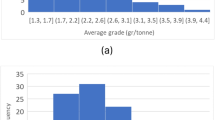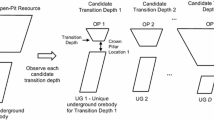Abstract
We present a mixed-integer programming model for solving the long-term planning problem of an underground mine. This model, which establishes the sequence of mining for a horizon of 20 years, determines which lens of the geological model will be mined and in what order, while respecting the operational constraints. For each lens to be mined, a specific cut-off grade has to be selected to maximize the net present value. The choice of a cut-off grade affects the volume and the average grade of each lens, which increases the size of problems to be solved. To reduce the computation time, different acceleration strategies and a Fix-and-Optimize heuristic are proposed. Computational experiments on instances of different sizes are performed to (1) assess the quality of the solution found by each method and (2) present the impact of the variable cut-off grade.






Similar content being viewed by others
References
Bley C, Boland N, Fricke C, Froyland G (2010) A strengthened formulation and cutting planes for the open pit mine production scheduling problem. Comput Oper Res 37:1641–1647
Caccetta L, Hill SP (2003) An application of branch and cut to open pit mine scheduling. J Global Optim 27(2–3):349–365
Dagdelen K, Kuchta M, Topal EM, Moreno E, Enrique R (2002) Linear integer programming model applied to scheduling of iron ore production at the kiruna mine. Trans Soc Min Metall Explor 312:194–198
Epstein R, Goic M, Weintraub A, Catalan J, Santibanez P, Urrutia R, Cancino R, Gaete S, Aguayo A, Caro F (2012) Optimizing long-term production plans in underground and open-pit copper mines. Oper Res 60(1):4–17
Gintner V, Kliewer N, Suhl L (2005) Solving large multiple-depot multiple-vehicle-type bus scheduling problems in practice. OR Spectr 27(4):507–523
Hansen P, Mladenović N (2001) Variable neighborhood search: principles and applications. Eur J Oper Res 130(3):449–467
Horsley T (2005) Differential cut-off grades. In: 9th AusIMM Underground Operators’ Conference, pp 103–109
Kuchta M, Newman A, Topal E (2004) Implementing a production schedule at lkab’s kiruna mine. Interfaces 34(2):124–134
L’Heureux G, Gamache M, Soumis F (2013) Mixed integer programming model for short term planning in open-pit mines. Min Technol Trans Inst Min Metall A 122(2):101–109
Little J, Knights P, Topal E (2013) Integrated optimization of underground mine design and scheduling. J South Afr Inst Min Metall 113(10):775–785
Martinez MA, Newman AM (2011) A solution approach for optimizing long and short-term production scheduling at lkab’s kiruna mine. Eur J Oper 211:184–197
Nehring M, Topal E (2007) Production schedule optimisation in underground hard rock mining using mixed integer programming. In: Australasian Institute of Mining and Metallurgy Publication Series, pp 169–175
Nehring M, Topal E, Kizil M, Knights P (2012) Integrated short-and medium-term underground mine production scheduling. J South Afr Inst Min Metall 112(5):365–378
Newman AM, Rubio E, Caro R, Weintraub A, Eurek K (2010) A review of operations research in mine planning. Interfaces 40(3):222–245
Pochet Y, Wolsey LA (2006) Production planning by mixed integer programming. Springer, New York
Pritsker A, Watters L, Wolfe P (1969) Multi-project scheduling with limited resources: zero-one programming approach. Manag Sci 16:93–108
Rahal D, Smith M, Van Hout G, Von Johannides A (2003) The use of mixed integer linear programming for long-term scheduling in block caving mines. In: Proceedings of the 31st International APCOM Symposium, Cape Town, South Africa, pp 123–131
Riff MC, Otto E, Bonnaire X (2009) A new strategy based on grasp to solve a macro mine planning. In: Rauch J, Ras Z, Berka P, Elomaa T (eds) Foundations of Intelligent Systems, vol 5722. Lecture Notes in Computer Science. Springer, Berlin, pp 483–492
Sarin S, West-Hansen J (2005) The long-term mine production scheduling problem. IIE Trans 37(2):109–121
Smith M, O’Rourke A (2005) The connection between production schedule and cut-off optimization in underground mines. In: Proceedings of the 32nd International APCOM Symposium, Tucson, Arizona, 2005. A.A.Balkema, Leiden, pp 643–654
Smith M, Sheppard I, Karunatillake G (2003) Using mip for strategic life-of-mine planning of the lead/zinc stream at mount ISA mines. In: Proceedings of the 31st International APCOM Symposium, Cape Town, South Africa, pp 465–474
Terblanche S, Bley A (2015) An improved formulation of the underground mine scheduling optimisation problem when considering selective mining. ORiON 31(1):1–16
Wang Q, Gu X, Chu D (2008) A dynamic optimization method for determining cutoff grades in underground mines. Gospodarka Surowcami Mineralnymi 24(4/2):133–142
Wolsey LA (1998) Integer programming. Wiley, New York
Acknowledgements
This research was partially supported by the Fonds de recherche du Québec - Nature et technologies (FRQ-NT) and by the Conselho Nacional de Desenvolvimento Científico e Tecnológico (CNPq), grants 313521/2017-4 and 425962/2016-4. All support is gratefully acknowledged. Computations were made on the supercomputer Mp2, managed by Calcul Québec and Compute Canada. The operation of this supercomputer is funded by the Canada Foundation for Innovation (CFI), the ministère de l’Économie, de la science et de l’innovation du Québec (MESI) and the Fonds de recherche du Québec - Nature et technologies (FRQ-NT). The authors would also like to thank the anonymous reviewers for their helpful and constructive comments that contributed to improve the final version of this paper, and Thibaut Vidal for helping with the figures.
Author information
Authors and Affiliations
Corresponding author
Additional information
Publisher's Note
Springer Nature remains neutral with regard to jurisdictional claims in published maps and institutional affiliations.
A Detailed Computational Experiments
A Detailed Computational Experiments
In this section, we present detailed information and results for all mine sizes and all approaches presented throughout the paper. Table 9 presents the number of lenses for each instance, in total and for each mine, and the number of variables, constraints, and non-zeros present in the MIP formulation. In Tables 10, 11, 12, 13, 14, 15, 16 and 17, we present the results for the original MIP formulation with the preprocessing procedure, for the Fix-and-Optimize Heuristic and for the MIP formulation using the Fix-and-Optimize heuristic solution as a hot-start. All results are presented using one thread and four threads, with a time limit of 12 hours for the MIP formulation.
Rights and permissions
About this article
Cite this article
Martinelli, R., Collard, J. & Gamache, M. Strategic planning of an underground mine with variable cut-off grades. Optim Eng 21, 803–849 (2020). https://doi.org/10.1007/s11081-019-09479-6
Received:
Revised:
Accepted:
Published:
Issue Date:
DOI: https://doi.org/10.1007/s11081-019-09479-6




